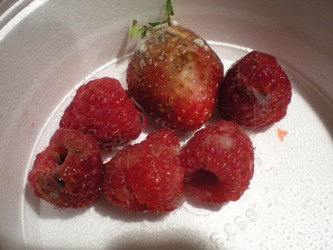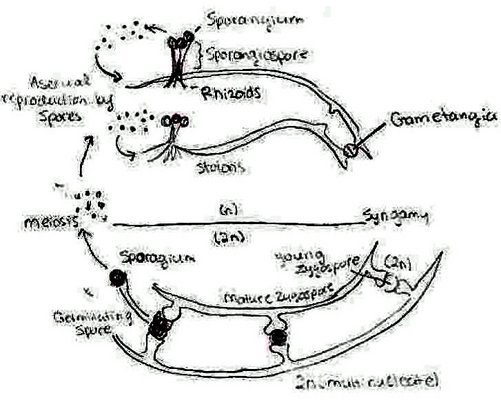SCIENTIFIC NAME AND COMMON NAME
Rhizopus stolonifer
Black Bread Mold
GENERAL DESCRIPTION OF THE ORGANISM
R. stolonifer is a threadlike mold and a heterotrophic species; it is dependant on sugar or starch for its source of carbon substances for food. It uses food matter, generally breads or soft fruits, like grapes or strawberries, as a food source for growth, nutrition and reproduction. R. stolonifer is a mass of mycelium, the vegetative filaments of the fungus, and a fruiting structure. Most of the mycelium is composed of multinucleate, rapidly growing hyphae. When the mold’s spores are released they produce more mycelium through germination. As the mold matures it begins to turn black.
R. stolonifer is an agent of plant disease; it breaks down organic matter through decomposition. When kept in a moist environment, such as a piece of bread, the parasite can quickly spread within a few days. Its spores are commonly found in the air. The spores grow most rapidly at temperatures between 15°C and 30°C where they are able to germinate to their full potential.
R. stolonifer has commercial use in the manufacturing of alcohol and organic acids.
The following video demonstrates R. stolonifer’s growth and reproduction on a piece of bread and an orange:
R. stolonifer


Figure 1. A magnification of R. stolonifer growing on a piece of bread. Spores are released into the air in order to create more sporangium made from mycelium. © Elizabeth Foody.

Figure 2. A photograph of R. stolonifer on soft fruits which were left out at room temperature for 2 days since their purchase. © Elizabeth Foody.
SPECIFIC HABITAT
Ripe fruit is most susceptible to R. stolonifer because of their moist environment which allows the mold to spread at fast speeds. Because R. stolonifer’s spore is so commonly found in the air the mold will often and quickly form upon any surface in which the mold can obtain food.
SPECIFIC ADAPTATIONS TO THE ENVIRONMENT
As long as there are R. stolonifer spores in the air the mold can grow off of fruits, vegetables and bread products. The temperature and the location where the rhizoid starts to grow can have an effect upon the speed at which the mold grows. If there is limited air the spores will not be able to spread stopping R. stolonifer from growing alltogether.
REPRODUCTIVE CHARACTERISTICS
R. stolonifer is different from all other fungi because it reproduces by sexual reproduction via zygospores following gametangial fusion, and it can also reproduce asexually by uni-to-multispored sporangia. In this process, nonmotile, single-celled sporangiospores are formed. In sexual reproduction, when two strains are close together, hormones cause their hyphal tips to come together. The positive and negative nuclei join together after the gametangia dissolve and form a zygospore which can become dormant for several months. During the process, meiosis occurs and a sporangium similar to the asexually produced sporangium is created when the zygospore cracks open.


Figure 3. The R. stolonifer's reproductive cycle. © Caroline Tong.
CLASSIFICATION
| Kingdom: | Fungi |
|---|---|
| Phylum: | Zygomycota |
| Class: | Zygomycetes |
| Order: | Mucorales |
| Family: | Mucoraceae |
| Genus: | Rhizopus |
| Species: | Rhizopus stolonifer |
IMPORTANCE OF THE ORGANISM TO THE ENVIRONMENT
The Black Bread Mold causes rotting of fruits and, in some cases, infections to humans. They grow inside food and use absorption to take in nutrients and dissolve the substrate with extracellular enzymes. Rhizopus stolonifer play a key role in the carbon cycle because they work as decomposers in soil, dung, and in many foods.
COMMON OR ENDANGERED?
R. stolonifer is one of the most common and fastest growing species in the Zygomycota. It often grows within a few days in moist and humid conditions because its spores are quite common in the air. The species is a common mold and is therefore not endangered at all; it grows on common foods and spreads very quickly.
THE ADVENTURE OF STOLO STOLONIFER
Once upon a time there was a strain of R. stolonifer named Stolo. Stolo was floating around the air, just waiting to latch onto a peach sitting out in the sun but he decided to drift farther and latched onto a strawberry instead. It was a hot, humid day, the perfect conditions for R. stolonifer to spread, so it was no surprise to Stolo that he wasn’t the first spore to form on the strawberry. As Stolo settled on the strawberry he instantly felt a connection to another spore which had a positively charged nucleus, the perfect match for his negatively charged nucleus. It was love at first infection. Their hyphal tips came together and the gametangia dissolved and a zygospore was formed. As the zygospore formed, the colony of R. stolonifer proceeded to take in the nutrients using absorption to decompose the strawberry. Thus ends the story of Stolo the R. stolonifer who fell in love one fateful day. A young zygospore was formed and the carbon cycle would continue successfully because the strawberry was effectively decomposed.
The End



 Go to quick links
Go to quick search
Go to navigation for this section of the ToL site
Go to detailed links for the ToL site
Go to quick links
Go to quick search
Go to navigation for this section of the ToL site
Go to detailed links for the ToL site